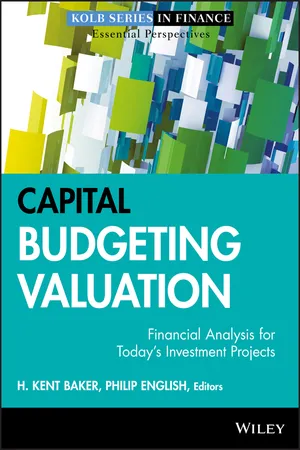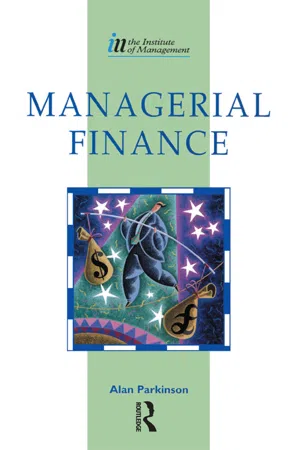Business
NPV vs IRR
NPV (Net Present Value) and IRR (Internal Rate of Return) are both financial metrics used to evaluate the profitability of an investment. NPV calculates the present value of future cash flows, while IRR represents the discount rate that makes the net present value of an investment zero. NPV is used to determine the absolute value of an investment, while IRR indicates the potential return on investment.
Written by Perlego with AI-assistance
Related key terms
Related key terms
1 of 4
Related key terms
1 of 3
12 Key excerpts on "NPV vs IRR"
- eBook - ePub
Finance for IT Decision Makers
A practical handbook
- Michael Blackstaff(Author)
- 2012(Publication Date)
- BCS, The Chartered Institute for IT(Publisher)
It was asserted earlier that NPV and IRR are the two sides of one coin: discounted cash flow. It should now be clear that this is indeed the case. Here is a summary that highlights the contrast between the two:While they are indeed two sides of the same coin, IRR has some practical limitations that NPV does not. These are as follows:- Net present value (NPV) is the absolute number obtained by applying a discount rate, usually equal to, or based on, the weighted average cost of capital, to a series of cash flows.
- Internal rate of return (IRR) is the discount rate that, when applied to a series of cash flows, both positive and negative, yields an NPV of exactly zero.
NPV, IRR AND RISK- IRR requires an initial cash outflow (an ‘investment’) in order to give a meaningful result; NPV does not.
- IRR gives a percentage result that, if not considered in the context of the size of an investment, can lead to misinterpretation; NPV is expressed as an absolute number, so the problem does not arise.
- Not so far considered is the fact that if, in a series of cash flows, the sign of the cumulative sum changes more than once, IRR will give multiple answers. This is because of the mathematics on which it is based. There is no such problem with NPV.
Earlier, we discussed why the discount rate used in NPV calculations for investment evaluation is usually the company’s weighted average cost of capital, or at least a value based on it. You will no doubt recall the fundamental reason for this. If the investment is the only one being considered, then a positive NPV means that we should be better off undertaking it than not doing so. A negative NPV says the reverse and the investment should not be undertaken. If we are comparing several similarly sized mutually exclusive investments, then the one that yields the largest positive NPV is the most desirable from a financial viewpoint. However, it may be that some investments being proposed are more risky, and therefore more uncertain in their outcome, than others. They would no doubt be subjected to sensitivity analysis and possibly other risk assessment methods. Dixon (1994) gives good descriptions, with examples, of the many methods of dealing with risk and uncertainty. The question is how, if at all, can discounted cash flow be used to take into account the relatively greater risk and uncertainty of one investment over another? - eBook - ePub
Making the Compelling Business Case
Decision-Making Techniques for Successful Business Growth
- W. Messner(Author)
- 2013(Publication Date)
- Palgrave Macmillan(Publisher)
Hence the IRR rule calls for the acceptance of business cases if their IRR is greater than the opportunity cost of capital. Many finance departments prefer the IRR rule to the NPV method. While mathematically both formulas are equivalent, the IRR method can be outright dangerous if not presented properly. In order to understand why one should always (!) use the much safer NPV method in business cases instead of the IRR rule, the following looks at four investment scenarios which are pitfalls in a sense that they directly lead to the wrong investment decision if their IRRs are blindly compared.Trap 1: Borrowing instead of investing
Not all projects necessarily have NPVs that decline as the opportunity cost of capital goes up. For instance, if one hurriedly compares the two projects A and B in Figure 2.10 , one might be tempted to think that they are equally attractive investments, as each one of them has an IRR of 6.38 per cent.So, where is the difference? Project A is the typical investment project discussed many times in this book; there is a cash outflow in period 0 followed by cash inflows in the subsequent periods. The NPV of project A therefore decreases as the discount rate is being raised. Project B, on the contrary, has an NPV which goes up as the discount rate is brought down. The company borrows money (cash inflow in period 0) and returns it over subsequent periods as cash outflows; it thus looks for a low rate of return. But when one invests (or lends) money, one looks for a high rate of return.Figure 2.10 IRR Trap 1: Borrowing in period 0When using the IRR method, one first needs to establish whether the investment project under scrutiny is about investing or borrowing as this determines whether a higher IRR or a lower IRR is desirable. While this is easy to make out from the simple cash flows in Figure 2.10 - eBook - ePub
- P. Cassimatis(Author)
- 2013(Publication Date)
- Routledge(Publisher)
When the cash flows are not uniform series, the IRR must be calculated by trial and error or using a computer program. Suppose that the expected cash flows of a $100,000 investment are as shown below. Using a discount rate of 14%, the present value of the cash flows is more than the cost of the investment of $100,000. If we try next a discount rate of 15%, the sum of the discounted cash flows is $98,244.By interpolation, we find that the incremental difference is 763 divided by (763+1,756), i.e. 0.3%. Therefore, we conclude that the IRR of the investment is 14.3%. (These calculations are easily performed with an electronic spreadsheet on a microcomputer.) When the IRR of an investment is greater than the cost of capital of the firm, the investment is accepted. Sometimes the internal rate of return must exceed the so-called required rate of return of the project or the firm's “minimum acceptable rate of return”.Figure 4.2 Net present value vs. internal rate of return.Whatever the hurdle rate, the IRR must exceed it, for an investment to be acceptable.NPV vs. IRR
Both the net present value method and the internal rate of return method are based on discounted cash flows. As Figure 4.2 illustrates, the NPV of a project is a function of its discount rate, and the project's IRR is the discount rate at which the NPV is zero.For the $100,000 project with $30,000 annual cash flows over 5 years, the NPV was found to be $13,724 and the IRR 15.2%. By plotting those two points to scale, a smooth curve can be fitted that shows the relationship of NPV to the discount rate. Therefore, as long as the cost of capital is less than the IRR (15.2%) the project has a positive NPV. If the cost of capital is greater than the IRR, the NPV is negative and the project should be rejected.4.3 Profitability index
In evaluating a capital project, one might ask what is the relationship of benefits to the cost of such an undertaking. The answer to this practical question is provided by the profitability index, or benefit-cost ratio, and it is mathematically expressed as - eBook - ePub
Finance
Capital Markets, Financial Management, and Investment Management
- Frank J. Fabozzi, Pamela Peterson Drake(Authors)
- 2009(Publication Date)
- Wiley(Publisher)
The index value is greater than one, which means that the investment produces more in terms of benefits than costs. An advantage of using the profitability index is that it translates the dollar amount of NPV into an indexed value, providing a measure of the benefit per dollar investment. This is helpful in ranking projects in cases in which the capital budget is limited.The decision rule for the profitability index depends on the PI relative to 1.0, which meansINTERNAL RATE OF RETURN
Suppose an investment opportunity requires an initial investment of $1 million and has expected cash inflows of $0.6 million after one year and another $0.6 million after two years. This opportunity is shown in Figure 14.3 using a time line.The return on this investment (denoted by internal rate of return or IRR, in the next equation) is the discount rate that causes the present values of the $0.6 million cash inflows to equal the present value of the $1 million cash outflow, calculated asAnother way to look at this is to consider the investment’s cash flows discounted at the IRR of 10%. The NPV of this project if the discount rate is 13.0662% (the IRR in this example), is zero:An investment’s internal rate of return is the discount rate that makes the present value of all expected future cash flows equal to zero. We can represent the IRR as the rate that solves Going back to Project X, the IRR for this project is the discount rate that solves Using a calculator or a computer, we get the answer of 10.172% per year.FIGURE 14.3Timeline of Investment OpportunityLooking back at the investment profiles of Projects X and Y, each profile crosses the horizontal axis (where NPV = 0) at the discount rate that corresponds to the investment’s IRR. This is no coincidence: by definition, the IRR is the discount rate that causes the project’s NPV to equal zero.The IRR is a yield—what is earned, on average, per year. How do you use it to decide which investment, if any, to choose? Let’s revisit Projects X and Y and the IRRs we just calculated for each. If, for similar risk investments, owners earn 10% per year, then both Projects X and Y are attractive. They both yield more than the rate owners require for the level of risk of these two investments: - eBook - ePub
Capital Budgeting Valuation
Financial Analysis for Today's Investment Projects
- H. Kent Baker, Philip English, H. Kent Baker, Philip English(Authors)
- 2011(Publication Date)
- Wiley(Publisher)
The dominance of NPV as a project evaluation method among academics does not appear to be shared by practitioners who often prefer to use IRR and the seemingly inferior PB measure. The use of PB appears to be a combination of focus on short-term liquidity needs (with or without an agency issue) and a cost-benefit analysis relative to project evaluation. In other words, safe or lesser valued projects do not warrant extensive analysis and are not good candidates for a NPV analysis.The popularity of IRR is more puzzling in that it is an imprecise rate of return metric. For instance, having an IRR of 13 percent versus an appropriate risk-adjusted return of 10 percent does not imply a gain of three percentage points. Consequently, the interpretation that people often assign to the IRR is incorrect because the percentage point gain can only be obtained if intermediate cash flows can appreciate at the IRR throughout the project's life. This “problem” became known as the “reinvestment problem,” which led to much research to better define the issue and to potentially mitigate the problem by calculating MIRR.MIRR is consistent with NPV because the NPV calculation is actually within the MIRR calculation. This equivalence can be seen by evaluating the MIRR calculation in terms of the PI, which is an NPV calculation in a ratio format. PI is generally not as useful as the NPV calculation, but PI does have some benefits when evaluating acceptable projects under a capital constraint.In general, all of these metrics are related in some fashion. IRR is the discount rate that sets NPV to zero, PI to one, and DPB and PBL to the duration of the project. An NPV > 0 implies that the project life is greater than PB, DPB, and PBL, PI > 1, and MIRR > cost of capital (or a hurdle rate). An NPV < 0 implies that the project life is less than DPB and PBL, PI < 1, and MIRR < cost of capital (or a hurdle rate). Being able to see these relationships allows the decision maker to use more than one metric, convert a given metric into another, and understand the biases of each metric. Ultimately, the decision maker should realize that these project evaluation techniques are simply tools to help in the decision-making process. All of the considerations necessary for making the decision are not contained within any one of these metrics alone or combined. - Martin Hopkinson(Author)
- 2017(Publication Date)
- Routledge(Publisher)
Internal rate of return IRR is a discounted financial modelling measure that is often used alongside or in place of NPV forecasts. IRR is defined as being the discount rate that would result in a project NPV of zero. It is possible to calculate IRR manually in very simple cases. Excel also has an IRR function. However, the usual procedure for obtaining IRR is to create an NPV model and use trial and error to determine the discount rate that results in an NPV that is sufficiently close to zero for the level of accuracy that is appropriate. As an example, the IRR for Model 2.2 is approximately 17%. A similar procedure can be employed with NPV risk models, using the mean NPV forecast equal to zero as the basis for obtaining the IRR.Organisations using IRR usually specify a hurdle rate for projects that must be exceeded in order for them to be approved. If this practice is intended to be consistent with the NPV rule, then the hurdle would be set at the relevant discount rate. However, organisations often choose to set a higher hurdle than this on the grounds of reluctance to accept the risk of proceeding with projects with business cases that are only marginal. Whilst this way of thinking is understandable, it can also be interpreted as being a form of blanket discount rate adjustment which, for reasons described earlier in this chapter, may have counterproductive effects.The advantage of IRR over NPV is that IRR is independent of project size. If, for example, you take any NPV model and double each cost and benefit input, you would double the NPV, but the IRR would remain constant. IRR can thus be a useful measure to report alongside NPV forecasts for large projects that appear to be attractive from an NPV perspective but are exposed as being marginal by their IRR.A perception that IRR provides a clearer comparison between projects than NPV is probably the most important cause of its widespread use. Unfortunately, the technique has limitations which, unless recognised, can lead to errors in project selection, particularly when relatively unusual cash flow patterns are involved. Brealey, Myers and Allen (2014) provide a good illustration of the types of circumstance in which the NPV and IRR measures can lead to contradictory evidence. Whereas NPV forecasts are based on today’s value of cash, and can thus be used as a rational basis for choice, IRR does not behave in a similarly consistent manner. A key conclusion from this is that IRR should not be used to choose between mutually exclusive options. When comparing different options for the same project the use of IRR would thus be incorrect.- Ivan E Brick(Author)
- 2017(Publication Date)
- WSPC(Publisher)
You are not sure how to answer that question but you learned a valuable lesson about capital budgeting. Finding the NPV or IRR is the easy part, but economics and marketing are still the keys to success of such ventures. If Honda is able to replicate the GM product quickly, then competition could eat into sales and the profit margin. You realize that your bosses were asking how does GM stay ahead of the competition to ensure the overall profitability of the new model. Without careful planning, the estimates of NPV and IRR are overly generous. You realize your omission and reply, “Mr. Wagoner and Mr. Hendrickson, I apologize. You are correct. If you give me a second chance, I will prepare a business strategy that incorporates what our competitors might do!”Now Mr. Hendrickson smiles and says, “Let’s have that by the end of this week!”Will NPV and IRR Always Give the Same Answer?
Generally speaking, whenever NPV > 0, the IRR will be greater than the cost of funds. However, the two approaches do not always agree on which project is best. This is important because many times firms must decide on two different strategies or two different manufacturing processes. In other words, management must decide between two different mutually exclusive projects. It is possible that the NPV and IRR will yield different answers.Reinvestment rate assumption of NPV and IRR: Consider the following two projects:In this example, we are assuming that the appropriate cost of funds is 10%. Note that IRR says that proposal A is the most profitable since clearly one would like a 25% return on investment rather than a 22% return on investment. The NPV tells us that Proposal B is the better project. This example illustrates that NPV and IRR do not have the same ranking. The reason for this is that NPV assumes that the cash flows of the project, which theoretically belongs to the owners of the firm, can be reinvested at the cost of funds of 10%. On the other hand, IRR assumes that the reinvestment rate for proposal A is 25% and for proposal B is 22%.Which one is correct? We believe that the NPV is correct. Why? To answer that question, we must understand the true meaning of the cost of funds. When we say that the cost of funds is 10%, we are saying that the owners of the firm are demanding that rate because that is the rate these investors can get in the market without the firm. In essence, if the investors were to receive a $10,000 dividend at time one, they would invest in the market in an investment vehicle of the same risk as the firm yielding 10%.- eBook - ePub
Multiple Interest Rate Analysis
Theory and Applications
- M. Osborne(Author)
- 2014(Publication Date)
- Palgrave Pivot(Publisher)
et al . (2011) contains a classic statement of the arguments and lists four pitfalls.1 An IRR, by itself, does not indicate whether a project involves borrowing or lending;2 Some cash flows cause the IRR equation to solve for more than one plausible IRR, resulting in ambiguity about which IRR to use as a criterion;3 NPV and IRR do not always rank mutually exclusive projects the same; the consensus opinion is that ranking by NPV is reliable, and therefore ranking by IRR is not;4 A non-flat yield curve provides more than one cost of capital with which to compare IRR leading to uncertainty about which cost of capital to employ.Despite the pitfalls there is considerable empirical evidence that the majority of practitioners continue to use IRR as an investment criterion and performance measure. For example, in the context of capital budgeting there is the study of US data by Graham and Harvey (2001) and the similarly executed study of European data by Brounen et al . (2004). Many studies of capital budgeting practice are published every year containing similar results for various countries. In the context of IRR as a performance measure for private equity firms, hedge funds, and venture capitalists see the works by Phalippou (2008), Phalippou and Gottschalg (2009), Dichev and Yu (2011), and Achleitner et al. - eBook - ePub
Strategic Entrepreneurial Finance
From Value Creation to Realization
- Darek Klonowski(Author)
- 2014(Publication Date)
- Routledge(Publisher)
Table 10.6 show that Project B has a higher NPV than Project A ($81,308.0 versus $71,298.7) and that Project A has a higher IRR compared with Project B (47.2 percent versus 38.3 percent). The entrepreneurial firm is now faced with conflicting decision-making criteria based on the NPV and IRR methods. If the projects were independent (i.e., both could be selected), then there would be no problem, as both projects generate a positive NPV and the IRR exceeds the required rate of return equal to 15 percent. Assuming that the projects are mutually exclusive, the entrepreneurial firm has to choose one. In situations of conflict between IRR and NPV, the project with the highest NPV should be selected because NPV indicates the dollar amount of value that is purported to be added to the value of the firm as a result of undertaking the capital budgeting project. In our case, Project B would be selected because its NPV value exceeds that of Project A.Table 10.6 A summary of net present value (NPV) and internal rate of return (IRR) results for Project A and Project BProject A B NPV 71,298.7 81,308.0 IRR 47.2% 38.3% Strategic considerations and real options
Many entrepreneurial firms deal with multiple strategic concerns such as the purchase of assets, marketing expenditures, new product introductions, research and development (R&D) investments, acquisitions of other firms, mergers with other firms, or undertaking other initiatives. Many of these investment opportunities have unique characteristics in that they have choices (or options) embedded within them. This special characteristic of investment projects, where single or multiple revisions to the project are possible, is called a “real option” (please note that this type of option is not a derivative financial instrument). Real options are sometimes called “growth options” as growth opportunities are often among the most popular strategic considerations (other types of real options also exist). These options are called “real” because they often involve real assets such as land, buildings, equipment, or machinery; they do not, however, have to involve tangible assets (as observed earlier). Real options allow us to approach the problems of strategic choice and financial investment as a collection of interdependent decisions.The flexibility provided by a real option to revise a project at a later date has value. Real options allow for a number of options: to grow (expanding the scope of operations by introducing new products or services); to expand or contract (increasing or decreasing the scale of operations depending on market opportunity and demand); to defer (adopting a “wait-and-see” approach to take action until another time when information can be received in order to allow for better decision making); to abandon (discontinuing the project); to tranche (committing to investing in stages or tranches in order to give rise to further evaluation); to switch inputs (altering the mix of inputs in the production process); to create another project on the basis of the initial investment (giving rise to follow-up opportunities that firms may or may not ultimately exploit); or to do something else. Real options allow a firm the flexibility to adapt its decision-making process in response to the changing conditions of the external market. Many industries in which entrepreneurial firms participate are filled with uncertainty, change, and competitive dynamics; hence, an understanding of real options can be valuable to entrepreneurial firms. In short, entrepreneurial firms can generate value by identifying, managing, and executing their real options in relation to their anticipated investment projects. - eBook - ePub
- Alan Parkinson(Author)
- 2012(Publication Date)
- Routledge(Publisher)
relative measure, since its comparative base must be the target rate of return.The profitability index is also a relative measure. It relates the present values of a project’s inflows to the present value of its outflows in order to establish the net present value per £ of investment.Both the internal rate of return and the profitability index are dependent upon the existence of negative cash flows – or investments of capital – into the projected earnings stream, otherwise they cannot be calculated. It is quite possible, however, to measure the net present value of a projected earnings stream which contains no net outflow.These are the main individual characteristics of the three discounting measures, but they do have their quirks and idiosyncrasies. What we will do next is to examine the variables that you managers should consider when interpreting the figures.The complicating variables
The impact of taxes and tax allowances
As they say, the only two certainties of life are death and the tax authorities, and the latter at least, surely applies to many organizations. In a healthy profit-making environment, a limited liability company (in whatever country) will be liable to pay some form of taxation on its net reported profits. Many countries operate a specific system which compensates for the vagaries and inconsistencies of the traditional accounting reporting mechanisms. Consequently, charges such as depreciation, which could vary between companies depending upon their management team’s viewpoint, are added back to the reported profits and a special system for taxation allowances applied. These allowances will alter the reported profit to a taxable profit upon which the company will be taxed. - eBook - ePub
- E.J. Mishan, Euston Quah(Authors)
- 2020(Publication Date)
- Routledge(Publisher)
outlay of 121 at the end of the second year – thus an investment stream equal to −100, 220, −121 – a discount rate equal to 10 per cent, reduces the present value of that stream to zero. The IRR is, therefore, equal to 10 per cent.Inasmuch, then, as in conforming to the formula, both outlays and benefits are to be discounted to the present at the IRR, it will sometimes be neater to obviate mention of the initial outlay K and any subsequent outlays, treating them instead as negative net benefits in the year they occur. The formula then becomesin which B t can be positive, negative or zero∑t = 0n= 0 ,B t1 + λtIt will be convenient, henceforth to continue using negative B s for any subsequent outlays. Nonetheless, it should be understood that, although there can also be negative net benefits in future years that are in fact not cash outlays, being instead possible losses arising from environmental damage or compensatory payment, it makes no difference in the calculation of the IRR – or, for that matter, of the DPV, given the discount rate.13 The sense in which the internal rate of return, so defined, is an average over time is conveyed by the example of a man investing, say, 100 for five years. If the internal rate of return of some given investment stream were 25 per cent per annum, the man would have in mind an equivalent , though simpler, investment in which his 100 in the present grows by 25 per cent each year. He sees his 100 in the present becoming 125 by the end of the first year,156.25by the end of the second year, and so on, to reach 100(1 + 0.25)5 by the end of the fifth year. More generally, if the investment stream in question were −100, B 1 , B 2 , B 3 , B 4 , B 5 , where the B s are any pattern of benefits, and the internal rate of return were known to be 25 per cent, then an equivalent investment stream would be −100,0,0,0,0, 100[(1 + 0.25)5 ], for this given investment stream, when discounted to its present value at 25 per cent, is, by assumption, equal to zero, and so also is the equivalent stream. Consequently, if a man is told that the internal rate of an investment stream over n years is equal to λ, he is justified in thinking of the investment as equivalent to one in which his initial outlay is compounded forward at the rate of λ per annum for n - eBook - ePub
Handbook of the Economics of Finance SET:Volumes 2A & 2B
Corporate Finance and Asset Pricing
- George M. Constantinides, Milton Harris, Rene M. Stulz(Authors)
- 2013(Publication Date)
- North Holland(Publisher)
This is a common situation in VC, where the dispersion of returns is substantial (see below). Second, the IRR overstates the variability of the true rate of return. Third, the IRR of aggregated and disaggregated cash flows differ, so that the average IRR of two venture funds differs from the IRR of the aggregated investments made by those two funds. When performance is negatively related to the duration of venture investments, as it turns out to be the case in venture investments, averaging IRRs computed over different time horizons is incorrect. 33 In realistic examples the average IRR can easily be two or three times the IRR of the aggregate underlying cash flows. One solution to these problems would be to use Net Present Values (NPV) for comparing performances, but in the case of VC it is particularly difficult to agree on what discount rate to use, and on what valuation to apply to companies prior to exit. Moreover, NPV is scale dependent, preventing direct comparisons across funds and investments. Phalippou (2008) discusses one possible solution to this, using a so-called modified IRR that employs a discount rate derived from the fund’s cash flows. One interesting observation is that the choice of performance measure itself may affect incentives, especially for timing investment and exit decisions. For example, the IRR measure provides an incentive to exit investments soon, even at the cost of forcing an outcome whose rate of return is lower. The negative effects of these incentives are relevant for portfolio companies, investors, and society as a whole. 5.2 Return Estimates We now turn to the main results in the literature on VC returns. There appears to be agreement among researchers that VC returns are not as high as those reported by industry participants and associations. Phalippou, 2011 compares the way returns are computed by industry associations and by academics. Beyond that, however, there is also a lively debate about what the true returns might be
Index pages curate the most relevant extracts from our library of academic textbooks. They’ve been created using an in-house natural language model (NLM), each adding context and meaning to key research topics.
Explore more topic indexes
Explore more topic indexes
1 of 6
Explore more topic indexes
1 of 4











